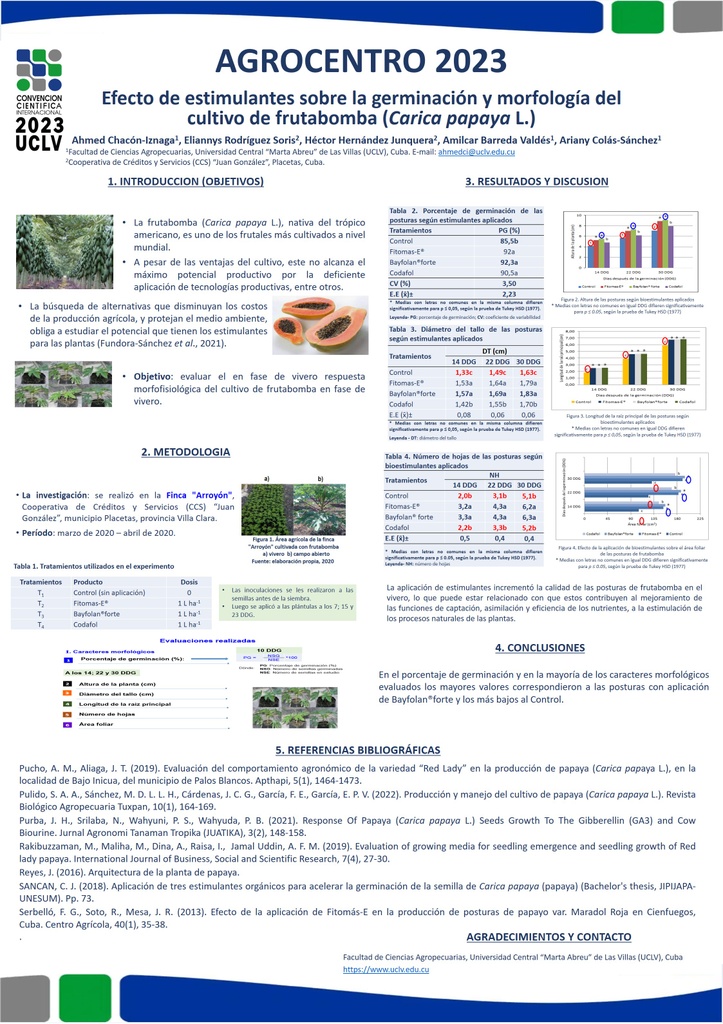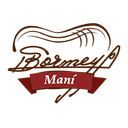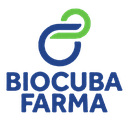Executive Secretary

IX Conferencia Científica Internacional sobre Desarrollo Agropecuario y Sostenibilidad
X Simposio de Agronomía

Resumen
• Problemática: la frutabomba (Carica papaya L.), nativa del trópico americano desempeña un papel importante en la dieta humana. Es uno de los frutales más cultivados a nivel mundial. Su establecimiento y manejo en vivero es la primera etapa del proceso productivo del cultivo y es fundamental para producir plantas sanas y vigorosas. En la provincia Villa Clara no se han definido las alternativas y dosis óptimas de estimulantes que maximicen de manera sostenible, la respuesta morfofisiológica del cultivo de frutabomba en fase de vivero.
• Objetivo(s): El trabajo se realizó con el objetivo de evaluar el en fase de vivero respuesta morfofisiológica del cultivo de frutabomba en fase de vivero.
• Metodología: Se desarrolló una investigación en la finca "Arroyón", perteneciente a la Cooperativa de Créditos y Servicios (CCS) “Juan González”, municipio Placetas, provincia Villa Clara. Se aplicaron los estimulantes Fitomas-E®, Bayfolan®forte y Codafol. Se utilizó el cultivar de frutabomba Maradol roja. Se evaluó el porcentaje de germinacióny los caracteres morfológicos.
• Resultados y discusión: Los resultados demostraron que la aplicación de estimulantes incrementó la calidad de las posturas de frutabomba en el vivero, lo que puede estar relacionado con que estos contribuyen al mejoramiento de las funciones de captación, asimilación y eficiencia de los nutrientes, a la estimulación de los procesos naturales de las plantas.
• Conclusiones: En el porcentaje de germinación y en la mayoría de los caracteres morfológicos evaluados los mayores valores correspondieron a las posturas con aplicación de Bayfolan®forte y los más bajos al Control.
Abstract
• Problematic: the papaya (Carica papaya L.), native to the American tropics, plays an important role in the human diet. It is one of the most cultivated fruit trees worldwide. Its establishment and management in the nursery is the first stage of the crop's production process and is essential to produce healthy and vigorous seedlings. In the Villa Clara province, the alternatives and optimal stimulant dose that sustainably maximize the morphophysiological response of bomb fruit cultivation in the nursery phase have not been defined.
• Objective(s): The work was carried out with the objective of evaluating the morphophysiological response of the papaya seedlings in the nursery phase.
• Methodology: An investigation was carried out on the "Arroyón" farm, belonging to the “Juan González” Credit and Services Cooperative (CCS), Placetas municipality, Villa Clara province. The stimulants Fitomas-E®, Bayfolan®forte and Codafol were applied. The papaya cultivar Maradol rojar was used. The germination percentage and morphological characters were evaluated.
• Results and discussion: The results demonstrated that the application of stimulants increased the quality of papaya seedlings in the nursery, which may be related to the fact that these contribute to the improvement of the functions of uptake, assimilation and efficiency of nutrients, to the stimulation of the natural processes of plants.
• Conclusions: In the germination percentage and in most of the morphological characters evaluated, the highest values corresponded to the positions with the application of Bayfolan®forte and the lowest to the Control.
Sobre el ponente

Dr. Ahmed Chacón Iznaga

Profesor Titular. Coordinador del programa de Doctorado en Ciencias Agrícolas. Vicedecano de Investigaciones, Postgrado e Internacionalización, Facultad de Ciencias Agropecuarias, UCLV
Discussion

